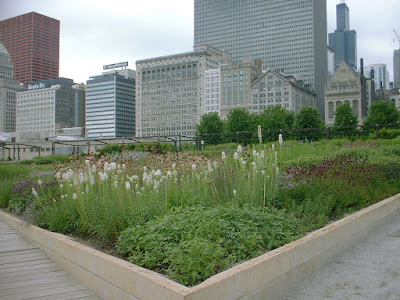The most nectar and pollen rich plants in our wildlife garden.

For the last couple of weeks the Red Admiral has been abundant in the Chicago region. Every time I step outside into the garden Red Admirals are flying. There are so many that any child that comes near our garden is lured into chasing these lovely creatures. Now the Monarchs are beginning to appear. It has been a good flying insect summer.
Unless you count mosquitoes. Apparently cooler weather, dry spells in between rains and the eradication spray programs instituted by local governments since West Nile reared its ugly head have had quite an effect. We have had no problem with mosquitoes in the gardens and very little on local hikes.

On a warm sunny afternoon the air over spotted Joe-pye weed is like an air traffic control nightmare.Butterflies, bees, tiny wasp and golden flies zoom about from flower to flower. It is the most active place in the garden. Maybe of all the plants in our garden.
We grow Spotted Joe-Pye Weed
Eupatorium maculatum (above picture in our garden- never watered). Many gardeners prefer the darker flowers and purple stems of Sweet Joe-Pye-weed
Eupatorium purpureum. Either will do well in average moist gardens. Living in the great lakes area no summer has been hot enough or dry enough, long enough to do damage to this plant. The six foot wooden fence is almost hidden behind this large specimen.

Another favorite of bees and butterflies in our garden is Echinacea purpurea / purple coneflower and Echinacea pallida.There are three areas in the gardens where Echinacea grows in big clumps/sweeps. Any passing pollinator will see that a stop is well worth while and may contemplate staying to raise a family in a spot with such abundant food and housing.

Over at Garden Rant Amy has posted about gardening for bees. She didn't ask but commentors are naming their best bee plants. The Joe-pye weed is currently the winner in this garden. But many other plants feed the bees.
Annual sunflowers, all the coreopsis, yellow coneflower,gallardia,helenium, liatris, milkweed, hyssop, blooming dill, fennel and several other herbs, even the last of the shasta daisies are drawing many bees this summer. Early the veronica was covered with many pollinators and late summer/fall the asters, sedums, and other eupatoriums do their share. I do not have goldenrod as I can not seem to pick one and to my surprise, none have volunteered
The yellow faced bees sighted last summer are back and I have seen cutter bees making circles in the leaf edges of the redbud tree. Also seen are bumble bees , carpenter bees and several unidentified tiny little sweat bee sized. I need a better camera and some patience to record all these creatures.




























